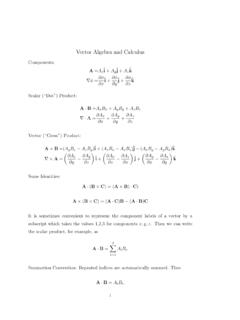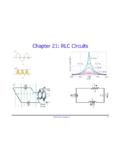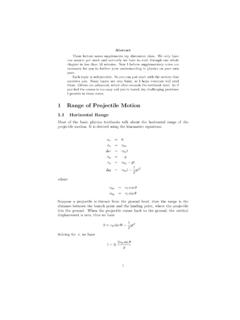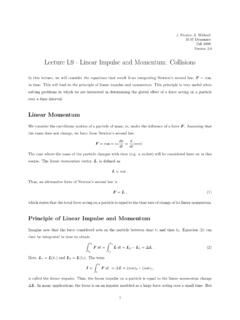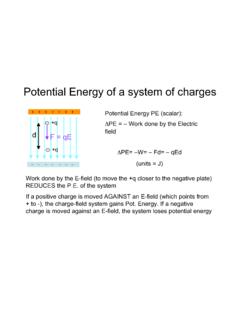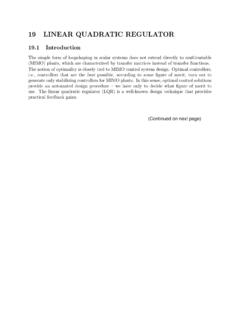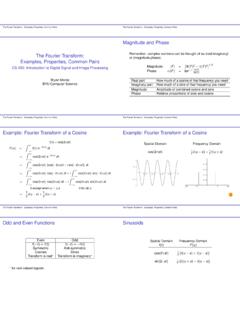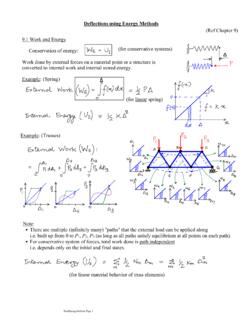Transcription of Electric Potential Work and Potential Energy
1 PHY2061 Enriched Physics 2 Lecture Notes Electric Potential D. Acosta Page 1 9/12/2006 Electric Potential Disclaimer: These lecture notes are not meant to replace the course textbook. The content may be incomplete. Some topics may be unclear. These notes are only meant to be a study aid and a supplement to your own notes. Please report any inaccuracies to the professor. Work and Potential Energy Applying a force over a distance requires work: 12 if and are constant otherwise to move the object from initial point i to final point ffiWWd= = FdFdFs The work done by a force on an object to move it from point i to point f is opposite to the change in the Potential Energy : ()fiWUUU= = In other words, if the work expended by the force is positive, the Potential Energy of the object is lowered.
2 For example, if an apple is dropped from the branch of a tree, the force of gravity does work to move (accelerate actually) the apple from the branch to the ground. The apple now has less gravitational Potential Energy . These concepts are independent of the type of force. So the same principal also applies to the Electric field acting on an Electric charge. We define the Electric Potential as the Potential Energy of a positive test charge divided by the charge q0 of the test charge. 0 UVq= It is by definition a scalar quantity, not a vector like the Electric field. The SI unit of Electric Potential is the Volt (V) which is 1 Joule/Coulomb. The units of the Electric field, which are N/C, can also be written as V/m (discussed later).
3 Changes in the Electric Potential similarly relate to changes in the Potential Energy : 0 UVq = PHY2061 Enriched Physics 2 Lecture Notes Electric Potential D. Acosta Page 2 9/12/2006 So we can compute the change in Potential Energy of an object with charge q crossing an Electric Potential difference: UqV = This motivates another unit for Potential Energy , since often we are interested in the Potential Energy of a particle like the electron crossing an Electric Potential difference. Consider an electron crossing a Potential difference of 1 volt: ()() 10 C 1 10 J = 1 eVUqVeV = = = = This is a tiny number, which we can define as one electron-volt (abbreviated eV ). It is a basic unit used to measure the tiny energies of subatomic particles like the electron.
4 You can easily convert back to the SI unit Joules by just multiplying by the charge of the electron, e. A common convention is to set the Electric Potential at infinity ( infinitely far away from any Electric charges) to be zero. Then the Electric Potential at some point r just refers to the change in Electric Potential in moving the charge from infinity to point r. rrVVV V = The work done by the Electric field in moving an Electric charge from infinity to point r is given by: ()rrWUqVqVV qV = = = = where the last step is done by our convention. But keep in mind that it is only the differences in Electric Potential that have any meaning. A constant offset in Electric Potential or Potential Energy does not affect anything.
5 Electric Potential from Electric Field Consider the work done by the Electric field in moving a charge q0 a distance ds: 0dWdqd= = FsEs The total work done by the field in moving the charge a macroscopic distance from initial point i to final point f is given by a line integral along the path: 0fiWqd= Es This work is related to the negative change in Potential Energy or Electric Potential : PHY2061 Enriched Physics 2 Lecture Notes Electric Potential D. Acosta Page 3 9/12/2006 ()0fiWVVVq= = fifiifVV Vdd = = = EsEs The last step changes the direction of the integration and reverses the sign of the integral. Equipotential Surfaces Equipotential surfaces are surfaces (not necessarily physical surfaces) which are at equal Electric Potential .
6 Thus, between any 2 points on the surface V=0. This implies that no work can be done by the Electric field to move an object along the surface, and thus we must have 0d =Es Therefore, equipotential surfaces are always perpendicular to the direction of the Electric field (the field lines). The Potential lines indicate surfaces at the same Electric Potential , and the spacing is a measure of the rate of charge of the Potential . The lines themselves have no physical meaning. Potential of a Point Charge Let s calculate the Electric Potential at a point a distance r away from a positive charge q. That is, let us calculate the Electric Potential difference when moving a test charge from infinity to a point a distance r away from the primary charge q.
7 RrVVVd = = Es Field lines Equipotential lines PHY2061 Enriched Physics 2 Lecture Notes Electric Potential D. Acosta Page 4 9/12/2006 Let us choose a radial path. Then dds = EsE since the field points in the opposite direction of the path. However, if we choose integrating variable dr, then dsdr= since r points radially outward like the field. We thus have: 221rrrrrVEdsEdrqdrdrqKKqKqKrrrr = = = = == Since the Electric Potential is chosen (and shown here) to be zero at infinity, we can just write for the Electric Potential a distance r away from a point charge q: ()qVr Kr= It looks similar to the expression for the magnitude of the Electric field, except that it falls off as 1/r rather than 1/r2.
8 We also could integrated in the opposite sense: rrVV Vd = = Es Then ddr =EsE 221rrrrrrrVVdEdrqdrdrqKKqKqKrrrrqVKr = = = = = == = Es Potential of Many Point Charges By the superposition principal, the Electric Potential arising from many point charges is just: iiiqVKr= where iqis the charge of the ith charge, and ir is the distance from the charge to some point P where we wish to know the total Electric Potential . The advantage of this calculation is that you only have to linearly add the Electric Potential arising from each point charge, rather than adding each vector component separately as in the case of the Electric field. PHY2061 Enriched Physics 2 Lecture Notes Electric Potential D.
9 Acosta Page 5 9/12/2006 Electric Dipole Let s see how to calculate the Electric Potential at point P due to an Electric dipole. By the superposition principle, the total Potential is: qqVV V KrrrrVKqrr+ + ++ = = = where r+ is the distance from the positive charge to point P, and r- the distance from the negative charge. Now for large distances, cosrd rrd + , where d is the separation of the Electric dipole. 22coscosdpVKqKrr == where rr r+ = and pqd is the Electric dipole moment. Potential of Continuous Charge Distributions Potential between 2 Parallel Plates Let s calculate the Electric Potential difference between 2 large parallel conducting plates separated by a distance d, with the upper plate (denoted + ) at higher Electric Potential than the lower.
10 From what we learned by Gauss s Law and conductors, we know that the Electric field arising from a conductor with a charge density is 0 =E. It is thus a constant between the two plates in this example. The Electric Potential difference is given by a line integral: + E ds y +q r+ P d r x q PHY2061 Enriched Physics 2 Lecture Notes Electric Potential D. Acosta Page 6 9/12/2006 opposite directionsVV VdddsVd++ = = = = EsEsEE Another way to view this result is that if we apply an Electric Potential difference between two conducting plates (large compared to their separation d), the magnitude of the Electric field between them is: Vd =E This motivates the alternate units for Electric field of V/m.
